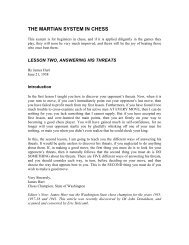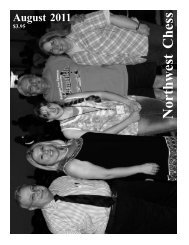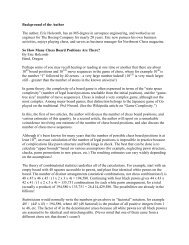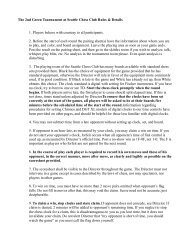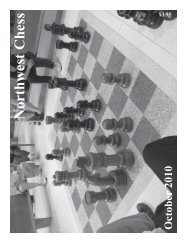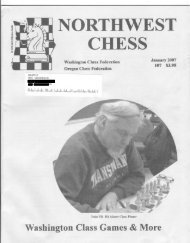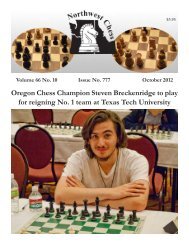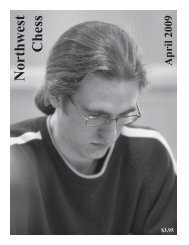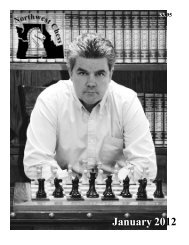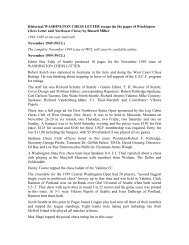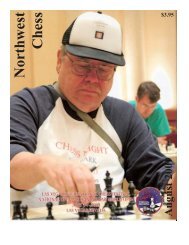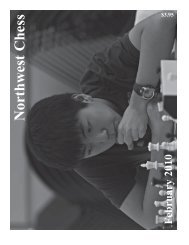April 2013 - Northwest Chess!
April 2013 - Northwest Chess!
April 2013 - Northwest Chess!
Create successful ePaper yourself
Turn your PDF publications into a flip-book with our unique Google optimized e-Paper software.
of the knight impossible. At this<br />
stage many victims in the 1960s and<br />
1970s capitulated with the obvious<br />
13.Bd4 running into 13...e5 which<br />
effectively ends the game as Black<br />
is two pawns up with no mitigating<br />
factors for White. The situation need<br />
not be this dire for the first player.<br />
Admittedly the situation is not great<br />
but after 13.Qd4 Qxd4 14.Bxd4<br />
White has enough play for one pawn<br />
but not enough for two.<br />
13...Qxb3<br />
More precise was 13...0–0 14.Kf1<br />
Nc5 15.Bd4 Qb4.<br />
14.axb3 Nc3+<br />
15.Kf2 Nxd1+ 16.Rexd1<br />
This was the game continuation<br />
and left White two pawns down but<br />
15.Kd2 Nxd1 16.Rxa7! Rxa7 17.Bxa7<br />
would have recovered some of the<br />
material as the knight has nowhere<br />
to go. Black would still be better but<br />
nothing like the game itself.<br />
John Julian (2054) -<br />
IM John Donaldson (2408) [E20]<br />
Dave Collyer Memorial Spokane<br />
(R4), Feb. 24, <strong>2013</strong><br />
1.d4 Nf6 2.c4 e6 3.Nc3 Bb4 4.f3<br />
This anti-Nimzo Indian line has<br />
become popular the past decade and<br />
helped GM Sam Shankland take third<br />
place in the 2011 US Championship.<br />
4...0–0 5.e4<br />
White has a serious alternative in<br />
transposing into the Samisch with<br />
5.a3 Bxc3+ 6.bxc3. I would have met<br />
this with the flexible 6...Ne8 shown<br />
to me by Bruce Harper over thirty<br />
years ago and a line I have always<br />
wanted to try.<br />
5...d5 6.cxd5<br />
Trading on d5 is the right decision.<br />
One example of the pitfalls that face<br />
White if he does not make this trade<br />
are seen in the line 6.e5 Nfd7 7.a3<br />
Bxc3+ 8.bxc3 dxc4 9.Bxc4 Nxe5.<br />
6...exd5 7.e5 Nfd7 8.a3 Bxc3+<br />
9.bxc3 f6<br />
10.exf6<br />
IM John Donaldson (left) vs. John Julian (right) during round four of the <strong>2013</strong> Dave Collyer Memorial.<br />
Photo credit: Jeff Roland.<br />
Correctly avoiding 10.f4 which<br />
is met by 10...fxe5 11.dxe5 Nxe5!<br />
12.fxe5 Qh4+.<br />
10...Qxf6 11.Ne2!<br />
John wants to make it harder for<br />
Black to solve the problem of how<br />
to develop his bishop. On the routine<br />
11.Bd3 Black has 11...Nb6 12.Ne2<br />
Bf5. The trade of light-squared<br />
bishops blunts White’s attacking<br />
ambitions and may enable a Black<br />
knight to find a good home on c4.<br />
Ideally the second player would like<br />
to establish a good knight versus bad<br />
bishop situation (...Nc4 versus Bc1).<br />
Of course this is a very long way off<br />
and much can happen in between!<br />
11...Nb6 12.Ng3 Nc6<br />
Black might have better in 12...<br />
c5, meeting 13.Bd3 with 13...cxd4<br />
14.cxd4 Nc6.<br />
13.Bd3 Ne7<br />
Black can force White to lose the<br />
castling privilege with 13...Re8+<br />
but after 14.Kf2 White’s king is<br />
comfortably placed and the rook may<br />
be better on f8.<br />
14.0–0<br />
[Diagram top of next page]<br />
Page 8 <strong>April</strong> <strong>2013</strong> <strong>Northwest</strong> <strong>Chess</strong>



